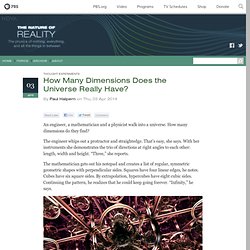

A Rationalist’s Mystical Moment. How Many Dimensions Does the Universe Really Have? - The Nature of Reality. An engineer, a mathematician and a physicist walk into a universe.

How many dimensions do they find? The engineer whips out a protractor and straightedge. That’s easy, she says. With her instruments she demonstrates the trio of directions at right angles to each other: length, width and height. “Three,” she reports. The mathematician gets out his notepad and creates a list of regular, symmetric geometric shapes with perpendicular sides. Credit: Sven Geier/Flickr, under a Creative Commons license.
Finally it is the physicist’s turn. Let’s see how she reached her conclusions. In 1917, Austrian physicist Paul Ehrenfest wrote a thought-provoking piece, “In what way does it become manifest in the fundamental laws of physics that space has three dimensions?” He noted, for example, that the stable orbits of planets in the solar system and the stationary states of electrons in atoms require inverse-squared force laws. Let’s think of what an inverse-squared law means. See The Ancient Roots Of Modern Infographics In "Book Of Trees" The first great Age of Infographics took root 1,000 years ago inspired variously by quests to categorize scientific knowledge, organize Greco-Roman scholarship and, weirdly, trace family bloodlines so that aristocrats could avoid incest as defined by Vatican rule-makers.

Manuel Lima's illustrated history The Book of Trees (Princeton Architectural Press) chronicles how Medieval-era designers instinctively used trunk and branch diagrams to impose order on the explosion of new data. One millennium later, tree-based graphics continue to pack considerable punch as information delivery systems. Lima, who first started pondering tree morphology in 2005 when he authored Visual Complexity: Mapping Patterns of Information, says, "It's too easy to think that information visualization is a new way to deal with the demands of all the big data we have in this century. In fact the Medieval period is the genesis of where information design and visualization comes from.
Stripped Down Tree. Akashic Records. The universe has a memory, like all that lives.

Deep in our unconscious there is a door that looks right there. "My brain is only a receiver. In the universe, there is a core from which we obtain knowledge, strenght, inspiration. I have not penetrated into the secrets of this core, but I know it exists" said Nikola Tesla. About the same time, Jung said the same thing. Deep in our unconscious, there's a gate looking right there. "Akashic Records are a place in heaven, a clear and peaceful place, where you felle really all right. A being called Coming-From-Far-Away channelled to Clairvoyant Brigitte. "From the beginning of the 20th century, popularized occultism books said that the astral light, also called akasha, reflects every event that happened in the universe.
The sum of these reflects makes "akashic records", that can be perceive by some people having this paranormal gift. This is your brain on religion: Uncovering the science of belief. As far as I’m concerned, the most interesting question about religion isn’t whether God exists but why so many people are religious.

There are around 10,000 different religions, each of which is convinced that there’s only one Truth and that they alone possess it. Hating people with a different faith seems to be part of belief. Around the year 1500, the church reformer Martin Luther described Jews as a “brood of vipers.” Over the centuries the Christian hatred of the Jews led to pogroms and ultimately made the Holocaust possible.
In 1947, over a million people were slaughtered when British India was partitioned into India for the Hindus and Pakistan for the Muslims. Almost 64 percent of the world’s population is Catholic, Protestant, Muslim, or Hindu. In 2006, during a symposium in Istanbul, Herman van Praag, a professor of biological psychiatry, taking his lead from the 95 percent of believers in the United States, tried to convince me that atheism was an “anomaly.” Gallery of mystery. Poems index.